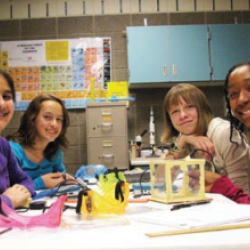Source Institutions
Source Institutions
Add to list Go to activity
Activity link broken? See if it's at the internet archive

In this physical sciences activity, learners explore how passive solar design increases energy efficiency. Learners test paperboard models of different building designs to discover how the design affects the amount of heat that enters the house.
- Under 5 minutes
- 1 to 2 hours
- $1 - $5 per group of students
- Ages 8 - 14
- Activity, Experiment/Lab Activity, Lesson/Lesson Plan
- English, Spanish
Quick Guide
Materials List (per group of students)
- 1 120 watt incandescent lightbulb
- 1 work light with clamp (or desk lamp capable of holding a 120 watt bulb)
- 1 stopwatch
- paperboard (e.g. cereal box, shoebox, tissue box)
- scissors
- ruler
- masking tape
- 1 thermometer
- markers
- paper and pencil
- plastic wrap for windows (optional)
Subjects
-
Earth and Space Science
-
Earth Processes
- Weather and Climate
- Earth, Moon and Sun
-
Solar System
- The Sun
-
Earth Processes
-
Engineering and Technology
-
Engineering
- Architectural Engineering
- Civil Engineering
- Environmental Engineering
- Metallurgy and Materials Engineering
-
Technology
- Construction
-
Engineering
-
Mathematics
- Algebra
-
Data Analysis and Probability
- Data Analysis
- Data Collection
- Data Representation
- Measurement
-
Physical Sciences
-
Heat and Thermodynamics
- Heat and Temperature
- Heat Transfer
- Energy
-
Vibration and Waves
- Light and Optics
-
Light and Optics
- Sunlight and Color
- Structure and Properties of Matter
-
Heat and Thermodynamics
-
The Nature of Science
-
The Scientific Process
- Asking Questions
- Conducting Investigations
- Gathering Data
- Formulating Explanations
- Communicating Results
-
The Scientific Process
-
The Nature of Technology
-
Technology and Society
- Impacts of Technology
- Technology and the Environment
-
Technology and Society
Informal Categories
- Nature and Environment
Audience
To use this activity, learners need to:
- see
- read
- touch
Learning styles supported:
- Involves teamwork and communication skills
- Involves hands-on or lab activities
Culture, ethnicity, and gender
-
Girls
- Explicity developed for this group
- Acknowledges this group's contributions to STEM
- Highlights STEM opportunities for this group
- Identifies role models or mentors in STEM fields from this group
- Uses inclusive images of people from this group
Other
Foreign language versions of this resource:
Components that are part of this resource:
Includes alignment to state and/or national standards:
This resource is part of:
Access Rights:
- Free access
By:
Rights:
- All rights reserved, Twin Cities Public Television, Inc., 2013
Funding Sources:
- National Science Foundation, DRL-1114739
- L'Oreal USA For Girls in Science
- Northrop Grumman Foundation
- PPG Industries Foundation
